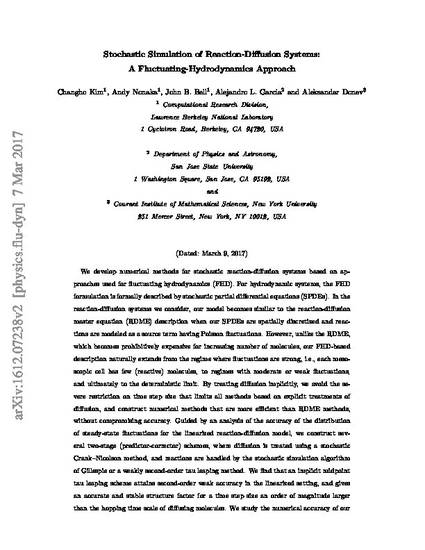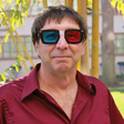
Article
Stochastic Simulation of Reaction-Diffusion Systems: A Fluctuating-Hydrodynamics Approach
Journal of Chemical Physics
(2017)
Abstract
We develop numerical methods for reaction-diffusion systems based on the equations of fluctuating hydrodynamics (FHD). While the FHD formulation is formally described by stochastic partial differential equations (SPDEs), it becomes similar to the reaction-diffusion master equation (RDME) description when those SPDEs are spatially discretized and reactions are modeled as a source term having Poisson fluctuations. However, unlike the RDME, the FHD description naturally extends from the regime where fluctuations are strong, i.e., each hydrodynamic cell has few (reactive) molecules, to regimes with moderate or weak fluctuations, and ultimately to the deterministic limit. By treating diffusion implicitly, we avoid the severe restriction on time step size that limits all methods based on explicit treatments of diffusion, and construct numerical methods that are more efficient than RDME methods, without compromising accuracy. We find that an implicit midpoint tau leaping scheme attains second-order weak accuracy for the linearized FHD, and gives an accurate and stable structure factor for a time step size an order of magnitude larger than the hopping time scale of diffusing molecules. We study the numerical accuracy of our methods for the Schl\"ogl reaction-diffusion model both in and out of thermodynamic equilibrium. We demonstrate and quantify the importance of thermodynamic fluctuations to the formation of a two-dimensional Turing-like pattern, and examine the effect of fluctuations on three-dimensional chemical front propagation. By comparing FHD simulations to deterministic reaction-diffusion simulations, we show that fluctuations accelerate pattern formation in spatially homogeneous systems, and lead to a qualitatively-different disordered pattern behind a traveling wave.
Disciplines
Publication Date
March 1, 2017
DOI
10.1063/1.4978775
Publisher Statement
This is the Accepted Manuscript of an article that appeared in Journal of Chemical Physics, volume 146, issue 12, 2017. The Version of Record (VOR) may be found at http://dx.doi.org/10.1063/1.4978775
Citation Information
Alejandro Garcia, Changho Kim, Andy Nonaka, John B Bell, et al.. "Stochastic Simulation of Reaction-Diffusion Systems: A Fluctuating-Hydrodynamics Approach" Journal of Chemical Physics Vol. 146 Iss. 12 (2017) ISSN: 0021-9606 Available at: http://works.bepress.com/alejandro_garcia1/94/
